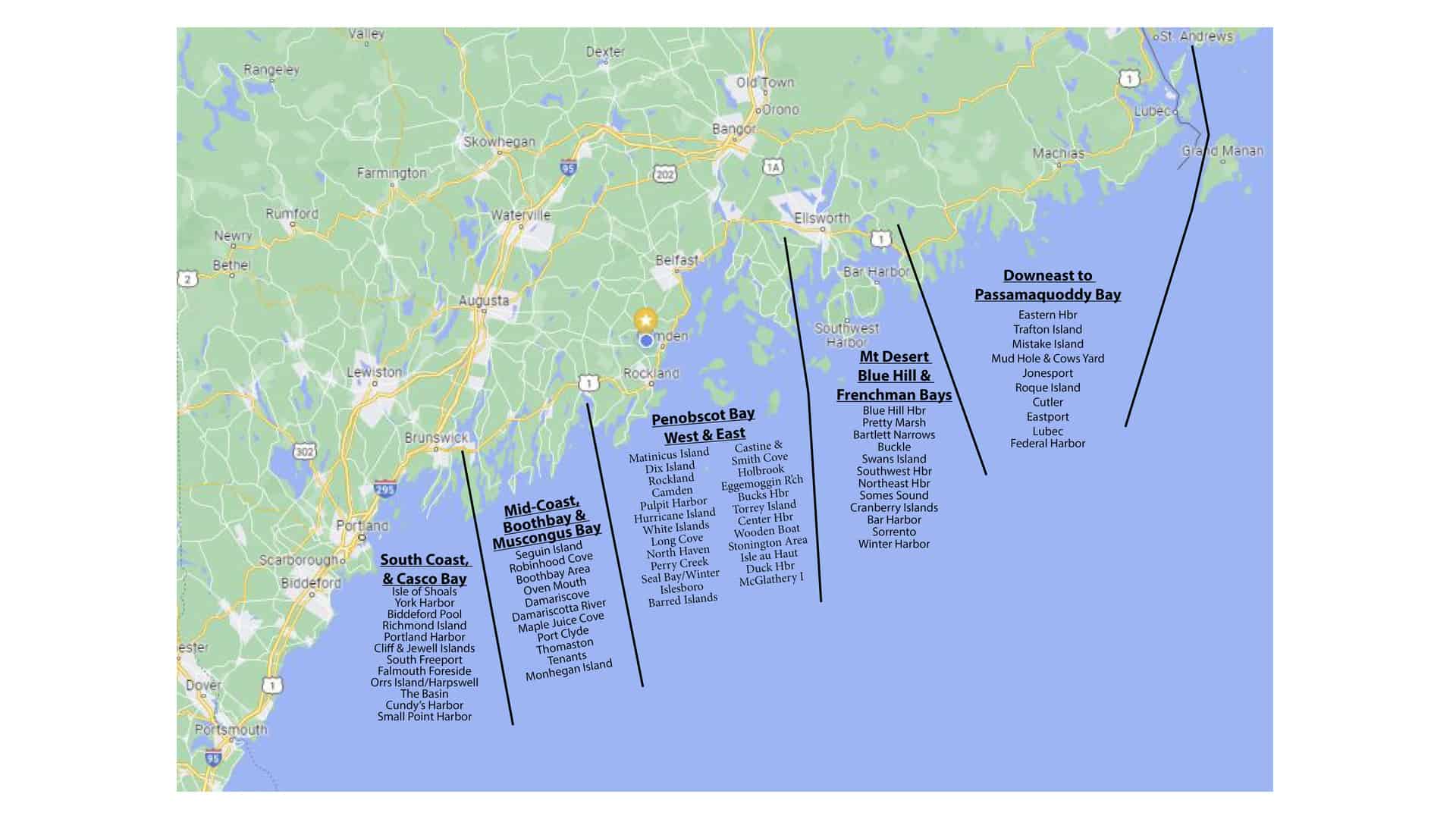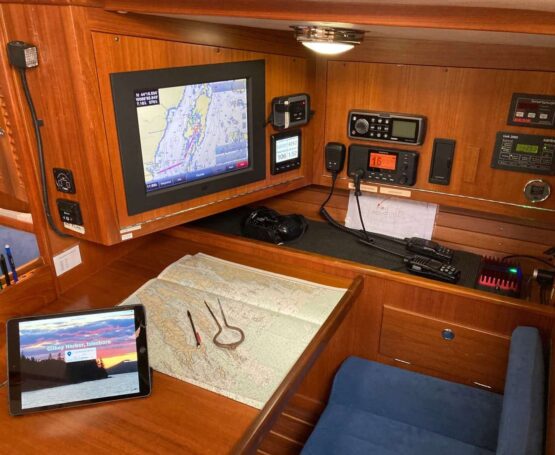There’s good and bad news about planning a cruise in Maine. The good news is that there are over 1000 destinations and 3,500 miles of coastline from which to choose. The bad news is that there are so many choices that it may seem impossible to come up with an enjoyable cruise itinerary. Fortunately, this CCA guide offers simple and informed solutions.
Planning Resources
The encyclopedic A Cruising Guide to the Maine Coast, a traditional book by Taft and Rindlaub, is considered by many as a must-have resource. Its 480 pages and more than a thousand destinations make for an exhaustive reference.
The ActiveCaptain app (designed to work with a Garmin Chartplotter and the new Aqua Map App) is interesting. It utilizes a multitude of crowd-sourced reviews from contributors with varying experience levels at different times over the past several years.
This CCA Cruising Guide to Maine – Favorite Harbors & Anchorages by the Cruising Club of America is written by deeply experienced members who have been cruising these waters for decades. The destinations featured are distilled to a core of nearly 80 highly recommended harbors and anchorages. All the information is online -- it is up-to-date and reviewed annually. Its qualitative assessments are augmented by an expansive array of online links to additional resources that give up-to-the-minute information on tides, weather, and shoreside amenities. Each listing includes a localized, scalable, scrollable electronic chart with range, bearing and routing features; a local digital weather forecast via Windy.com; and a local tide prediction courtesy of US Harbors. Also included in the guide under Cruising Advice are four suggested itineraries covering Portland to Roque Island, two Hiking Itineraries covering Portland to Cutler, and two Provisioning Guides covering Portland to Mount Desert Island.
Planning Overview
It seems that every time we get into the launch or dinghy with bags of provisions, books, and other paraphernalia, someone will ask where we are headed on our cruise—be it an overnight, a weekend, or a month. Our answer is always the same and seems to confound the questioner: “We have no plan.” We have learned that schedules with hard-and-fast plans are the antitheses of safe and enjoyable cruising. We may start each day with a general idea of where we will go, but that often evolves as the day progresses. We’ve been known to start sailing as the wind fills in, sail all day long and end up back where we started.
Not everyone is comfortable cruising without a plan, so you might consider creating a Half Plan. A Half Plan might have a final destination on a particular date and perhaps a handful of other objectives in mind -- maybe one objective for every two days of the cruise. This leads to lots of flexibility in the schedule, making for a low-stress and creative cruising experience without being independent of any itinerary or particular goals.
Of course, the third option is a Full Plan, e.g., ten days, ten destinations. It might give one the feel of a forced march, but perhaps having a full itinerary and checking all the boxes fits the personality and energy level of the captain and crew.
Planning Considerations
Once you have determined whether No Plan, Half Plan or Full Plan suits your situation best, the next step is to think about the variables that need to be considered.
- What is your time horizon: open-ended, or will you have to return home in a week? Or will you do multiple short cruises and need to leave the boat in between sails?
- Crew capabilities: Age, experience, bad weather tolerance, frequency of needing to go ashore for exercise, hiking, ice cream, pets, or change of venue, to name a few.
- Boat capabilities: Is your boat a proven offshore, all-weather vessel, or a coastal cruiser? What is a comfortable maximum daytime range for the boat and crew? 20 miles? 40 miles? More? Remember that sailing at night is rare due to the difficulty of seeing lobster buoys after dark.
- What is your tolerance for motoring rather than sailing? Remember that while the sea breeze in Maine is truly glorious, it frequently doesn’t materialize until after lunch.
- Is the crew adventurous or laid back? Is a three-mile hike a must every day, or is reading and napping a greater priority?
- What will the balance be between dockage, moorings, or anchoring?
- What type of destinations are preferred? A bustling town with restaurants and other attractions, remote anchorages, or something in between? Remember that offshore islands are attractive when the weather is hot, while destinations surrounded by land and further inland are often an effective way to escape fog.
- What is the provisioning plan? Does the boat have a generous freezer and refrigerator, easily going a week or two without reprovisioning, or will you be looking for a well-stocked grocery store every few days?
- Is the crew interested in dinner ashore almost every night, occasionally or rarely?
- How many fixed date and place obligations will there be, such as crew changes, visiting friends, attending events?
- Are there times when the crew requires good WiFi or a strong cellular signal for a Zoom meeting, a conference call, or checking in with family or friends?

Planning Locations
Where will the cruise begin and end? We have met many first-time cruisers that never got past Portland, or got to Penobscot Bay, spent one day, then had to turn around and head back. That is most unfortunate. We began our cruising life with a home port of York. On our vacation cruise, we would make a straight run to Casco Bay. That lasted about two years before we acquired a mooring in South Freeport, which allowed us to cruise that area on weekends, but for a vacation cruise, we would immediately head directly to Penobscot Bay. For the last 30 years, we have been homeported in Camden, and quite honestly, we’ve never gone back westward. Other guide editors extoll the virtues of their favorite geographic area. For some, getting to Roque Island is the only thing that matters.
- Between Isle of Shoals on the South Coast, and Portland plus Casco Bay (about 25 nm from Cape Ann, Massachusetts, and another 60 nm to the east side of Casco Bay), there are about 15 recommended destinations.
- Along the Mid-Coast, including Boothbay and Muscongus Bay (30 nm), there are about 10 recommended harbors and anchorages.
- Within Penobscot Bay which covers a wide (30 nm) and deep (30 nm) section of the coast, there are approximately 25 recommended places.
- Around Mt. Desert Island plus Blue Hill and Frenchman Bays (just 20 nm wide and up to 20 nm deep), there approximately 10 recommendations.
- For the Downeast Coast from Mt Desert Island to Passamaquoddy Bay (as much as 70 nm), you’ll find about 10 favorites -- all rugged and fascinating destinations.
This will give you some perspective on how to plan your cruise. No matter your cruising style and dedication, or aversion to planning, there is truly something for everyone.

